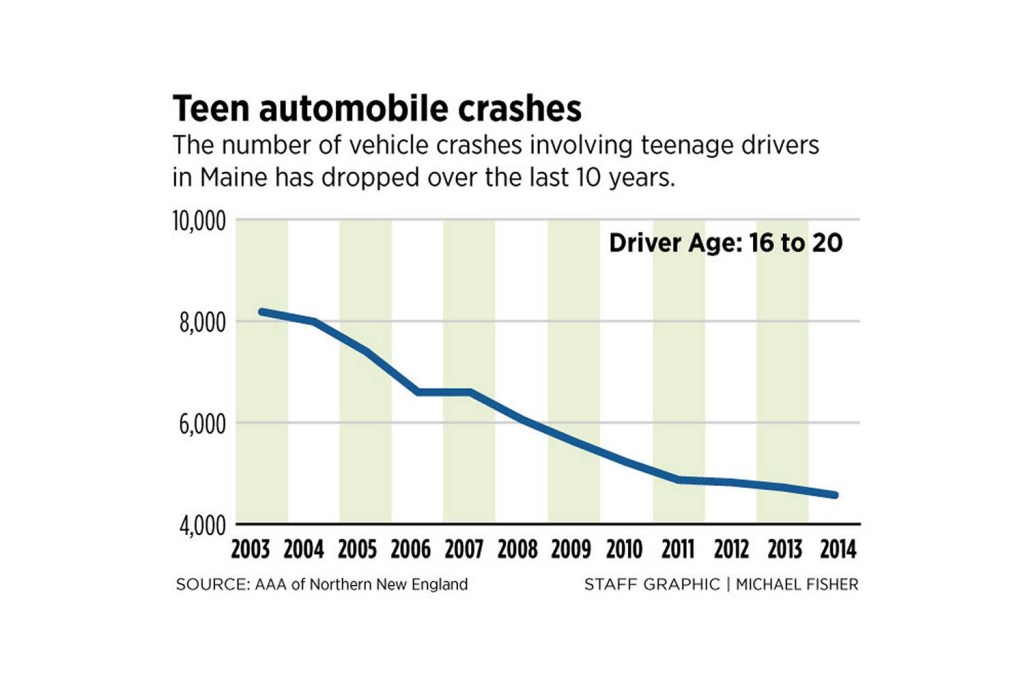The months from Memorial Day to Labor Day are the worst for fatal crashes involving teenage drivers, but Maine’s traffic crashes involving teen drivers have dropped consistently for more than a decade.
That’s a sign education and other safety initiatives are working, officials say.
As part of a campaign dubbed “the 100 Deadliest Days,” AAA released statistics showing that nationwide, the average number of fatalities for teen drivers in the summer months was 43 percent higher than the rest of the year. That’s largely because young drivers, like other Americans, drive more in the summer, and they also tend to be less experienced. But it’s also because they have more unobserved leisure time.
“Summer vacation comes with more freedom and less structure and less parental oversight,” Pat Moody, spokesman for AAA of Northern New England, said at a news conference at the regional headquarters in Portland.
Teen crash rates are higher than any other age group, Moody said, citing data from the AAA Foundation for Traffic Safety showing that 2,927 people were killed and 371,645 injured nationwide in 2013 in crashes that involved a teen driver.
Several steps help reduce the likelihood of a teen driving crash, Moody said.
In Maine, teen drivers are initially issued an intermediate license that prohibits them from driving between midnight and 5 a.m., while using a cellphone or transporting any passengers besides immediate family, unless a person at least 20 years old with a license for at least two years is in the passenger seat.
A young driver can then graduate to a provisional license, which allows the state to suspend the license for 30 days for any driving infraction. That continues until the driver is 21, said Secretary of State Matthew Dunlap.
“It’s an incentive for kids to keep in mind what they learned in driver’s education, get that into their muscle memory,” Dunlap said. “Once you get to a certain point, it has nothing to do with how old you are, it’s how much experience you have.”
Dunlap says improvements in car manufacturing, law enforcement, driver education and laws all have played a part in reducing teen crashes and injuries.
The latest move is a pilot program in which the department makes available decals that indicate the possibility of an intermediate licensed driver, which allows an officer to pull over a car that he suspects may have an intermediate driver carrying non-family members.
The department will collect data on the program and report to a future legislative session, where lawmakers will consider making it a mandate.
According to data from the Maine Department of Transportation, the number of crashes involving teen drivers has declined almost every year since 2003 – from 8,182 to 4,572 in 2014.
Dylan Wike, a 16-year-old sophomore at Portland High School who spoke at Friday’s event, said he understands the temptation to give friends a ride or check his cellphone at a red light.
Instead, he puts his cellphone away so he is not tempted to check it, and declines friends’ requests for a ride, saying it’s not worth risking his license and the freedom to drive.
Motor vehicle crashes are the leading cause of death for people 15 to 19, but nearly two-thirds of the people killed in crashes where at least one driver was a teenager were not teens, but passengers, other motorists or pedestrians, Moody said.
Send questions/comments to the editors.



Success. Please wait for the page to reload. If the page does not reload within 5 seconds, please refresh the page.
Enter your email and password to access comments.
Hi, to comment on stories you must . This profile is in addition to your subscription and website login.
Already have a commenting profile? .
Invalid username/password.
Please check your email to confirm and complete your registration.
Only subscribers are eligible to post comments. Please subscribe or login first for digital access. Here’s why.
Use the form below to reset your password. When you've submitted your account email, we will send an email with a reset code.